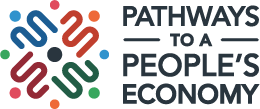Resource and incentivize community-owned and democratically-controlled housing solutions
Governments at all levels must prioritize direct assistance, tax subsidies and incentives, and low-interest loans to housing that is community owned or controlled, is participatory in its governance structures, and “locks in” affordability so as to prevent displacement from gentrification and speculation. Specifically, the policies outlined below will help communities develop and maintain long-term affordable, community-controlled housing models including Community Land Trusts (CLTs), Limited or Zero Equity Cooperatives, and Resident-Owned Communities.

The first community land trust in the US, New Communities Inc; Source: equitytrust.org
Community Land Trusts (CLTs)
“CLTs are nonprofit organizations that acquire and steward land in a “trust” for the permanent benefit of low-income communities. A CLT holds ownership of land in perpetuity, while residential and commercial tenants own the homes, stores, and other structures established atop the land via a ground lease with the CLT organization. By separating ownership of the land and the residential or commercial developments on the land in this manner, a CLT can ensure that public and private investments used to maintain the affordability of the housing and other establishments remain within a community for generations. Core to this strategy are the limits placed on the amount of equity a CLT lessee is able to pocket at the time of resale or property transfer as well as the tripartite governance system which provides CLT lessees, community members, and CLT managers with equal representation and decision-making power in the CLT.”
(Source: Democracy Collaborative Elements of the Next System: https://thenextsystem.org/learn/stories/community-land-trust)
Limited Equity Cooperatives
“A limited equity housing cooperative is a residential development owned and managed by a democratically governed, nonprofit cooperative corporation, such as a tenants’ union. This tenants’ union (or similar organization) is composed of members of the LEHC, which usually owns the property through a blanket mortgage covering all of the units. As indicated in the name, an LEHC limits the amount of equity a member can earn upon resale of their unit (and membership share) in order to preserve the cooperative’s affordability for future generations.”
(Source: Democracy Collaborative Elements of the Next System: https://thenextsystem.org/learn/stories/limited-equity-housing-cooperative)
Resident-Owned Communities
“Resident-owned communities (ROCs) are manufactured housing neighborhoods (sometimes referred to as mobile home or trailer parks) in which the land is community-owned and managed. An estimated 18 million people who earn less than $28,000 a year (less than half the national household median income) live in manufactured housing. That makes it one of the leading sources of affordable housing in the U.S. Approximately 1,000 manufactured housing communities are resident-owned around the country (especially throughout New England). This includes the 10,000 manufactured homes that are part of network of ROCs organized by ROC USA, a nonprofit enterprise that works to scale ROCs in the United States.”
(Source: Democracy Collaborative Elements of the Next System: https://thenextsystem.org/learn/stories/resident-owned-community)
Make 50% of publicly owned vacant land available to community-owned / democratically-controlled housing at nominal or below-market prices
For example:
- Bay Area Community Land Trust in Berkeley, California, is partnering with a group of seniors who are forming a permanently affordable housing cooperative, Hibiscus Commons. BACLT is working with the city of Berkeley to identify vacant property that might be dedicated for this purpose, among other permanently affordable housing projects.
Move privately owned vacant properties into land banks accountable to communities for disposition, with priority to community-owned / democratically-controlled housing models
Prioritize funding for community-owned / democratically-controlled housing in Local Housing Trust Funds and housing spending (Bonds, CDBG, HOME, etc.)
For example:
- In Baltimore, members of the Baltimore Housing Roundtable created the Baltimore 20/20 Campaign, a grassroots led political mobilization that worked to devote a significant portion of the city’s capital budget – $20 million – to Community Land Trusts and other permanently affordable housing models (targeting those from 0-50% of Area Median Income [AMI]).
Prioritize and expand public subsidies available to enable deeper affordability, and prioritize permanently affordable, community-controlled developments.
For Example:
- The Mitchell-Lama Housing Program in New York, created in 1955, facilitates the development and building of co-operative and rental housing by providing developers of such housing tax abatements and low interest mortgages, subsidized by the federal, state or New York city government. The program was based on the Morningside Housing Co-op, that was subsidized with tax money.
Require building, rehabbing, or funding of community owned/ democratically-controlled housing in exchange for public subsidies and/or land use accommodations provided to for-profit developers.

